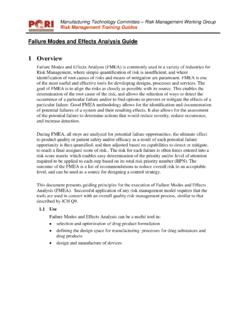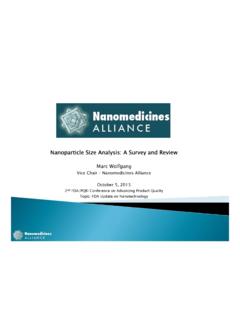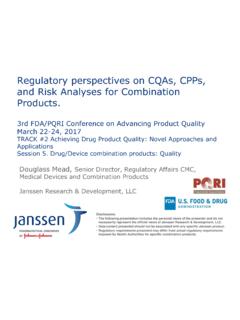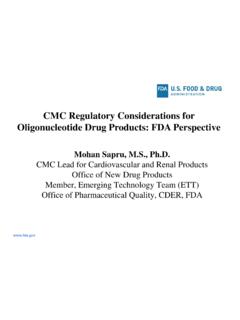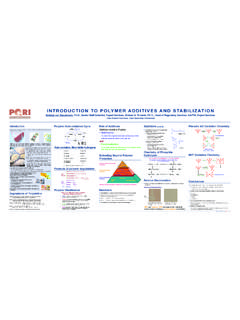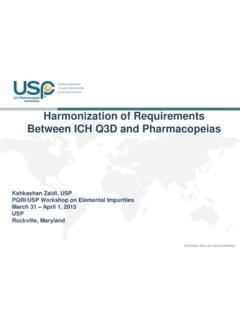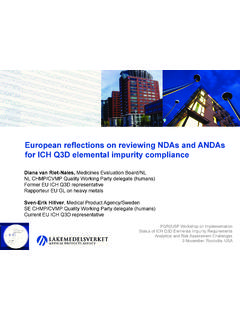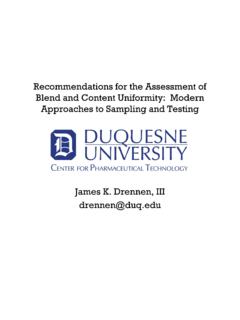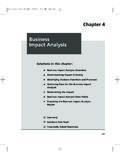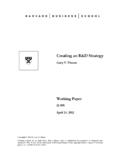Transcription of Hazard & Operability Analysis (HAZOP) 1 Overview
1 Manufacturing Technology Committee Risk Management Working Group Risk Management Training Guides Hazard & Operability Analysis ( hazop ). 1 Overview Hazard and Operability Analysis ( hazop ) is a structured and systematic technique for system examination and risk management. In particular, hazop is often used as a technique for identifying potential hazards in a system and identifying Operability problems likely to lead to nonconforming products. hazop is based on a theory that assumes risk events are caused by deviations from Definition: SYSTEM is the design or operating intentions.
2 Identification of such deviations is subject of a risk facilitated by using sets of guide words as a systematic list of assessment and generally deviation perspectives. This approach is a unique feature of the includes a process, hazop methodology that helps stimulate the imagination of team product, activity, facility members when exploring potential deviations. or logical system. As a risk assessment tool, hazop is often described as: A brainstorming technique A qualitative risk assessment tool An inductive risk assessment tool, meaning that it is a bottom-up risk identification approach, where success relies on the ability of subject matter experts (SMEs) to predict deviations based on past experiences and general subject matter expertise The ICHQ9 Guideline, Quality Risk Management endorses the use of hazop (amongst other allowable tools) for pharmaceutical quality risk management.
3 In addition to its utility in Quality Risk Management, hazop is also commonly used in risk assessments for industrial and environmental health and safety applications. Additional details on the hazop methodology may be found within IEC International Standard 61882, Hazard and Operability Studies ( hazop ) Application Guide. This document presents some guiding principles in the execution of hazop analyses. Successful application of any risk management model requires that tools are used in concert with the overall quality risk management process.
4 This guide will present the principles of hazop in the context of the accepted Quality Risk Management process consisting of Risk Assessment, Risk Control, Risk Review and Communication and is intended to compliment (not replace or repeat) the guidance available within IEC International Standard 61882. Definitions When describing the hazop methodology, the following definitions1 are useful: Hazard - Potential source of harm. Deviations from design or operational intent may constitute or produce a Hazard .
5 hazards are the focus of hazop . studies, and it should be noted that a single Hazard could potentially lead to multiple forms of harm. Page 1 of 9. Training Guide: Hazard & Operability Analysis ( hazop ). Harm - Physical injury or damage to the health of people or damage to property or the environment. Harm is the consequence of a Hazard occurring and may take many forms: patient or user safety, employee safety, business risks, regulatory risks, environmental risks, etc. Risk - Combination of probability of occurrence of harm and the severity of that harm.
6 In a strict sense, risk is not always explicitly identified in hazop studies since the core methodology does not require identification (also referred to as rating) of the probability or severity of harm. However, risk assessment teams may choose to rate these factors in order to further quantify and prioritize risks if needed. Usage hazop is best suited for assessing hazards in facilities, equipment, and processes and is capable of assessing systems from multiple perspectives: Design o Assessing system design capability to meet user specifications and safety standards o Identifying weaknesses in systems Physical and operational environments o Assessing environment to ensure system is appropriately situated, supported, serviced, contained, etc.
7 Operational and procedural controls o Assessing engineered controls (ex: automation), sequences of operations, procedural controls (ex: human interactions) etc. o Assessing different operational modes start-up, standby, normal operation, steady & unsteady states, normal shutdown, emergency shutdown, etc. Advantages Disadvantages + Helpful when confronting hazards that - No means to assess hazards involving are difficult to quantify interactions between different parts of a hazards rooted in human system or process performance and behaviors - No risk ranking or prioritization hazards that are difficult to detect, capability analyze, isolate, count, predict, etc.
8 Teams may optionally build-in such Methodology doesn't force you to capability as required explicitly rate or measure deviation - No means to assess effectiveness of probability of occurrence, severity of existing or proposed controls (safeguards). impact, or ability to detect May need to interface hazop with + Built-in brainstorming methodology other risk management tools (ex: + Systematic & comprehensive HACCP) for this purpose methodology + More simple and intuitive than other commonly used risk management tools Page 2 of 9.
9 Training Guide: Hazard & Operability Analysis ( hazop ). 2 hazop Methodology1. The hazop Analysis process is executed in four phases as illustrated below: Definition Preparation Define scope and objectives Plan the study Define responsibilities Collect data Select Team Agree style of recording Estimate the time Arrange a schedule Examination Documentation and Divide the system into parts follow-up Select a part and define design intent Record the examination Identify deviation by using guide words on each Sign off the documentation element Produce the report of the Identify consequences and causes study Identify whether a significant problem
10 Exists Follow up that actions are Identify protection, detection, and indicating implemented mechanisms Re-study any parts of system Identify possible remedial/mitigating measures if necessary (optional). Produce final output report Agree actions Repeat for each element and then each part Definition Phase The Definition Phase typically begins with preliminary identification of risk assessment team members. hazop is intended to be a cross-functional team effort, and relies on specialists (SMEs) from various disciplines with appropriate skills and experience who display intuition and good SMEs should be carefully chosen to include those with a broad and current knowledge of system deviations.
